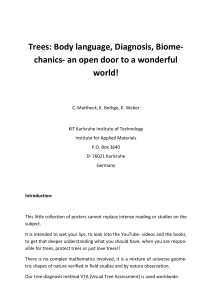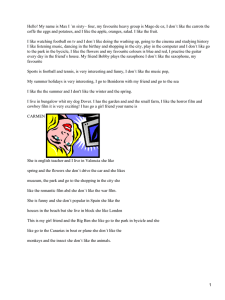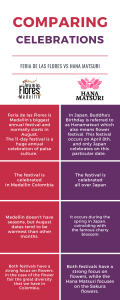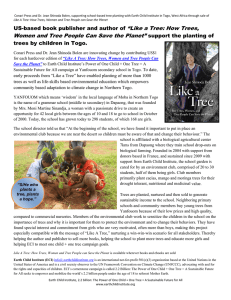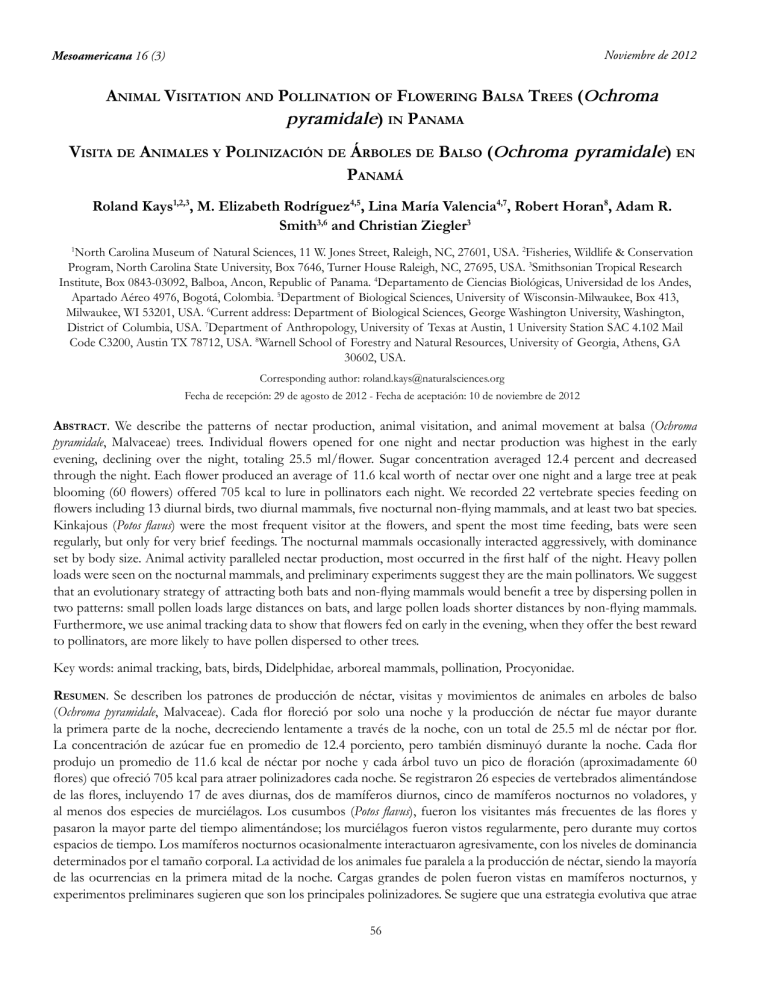
Noviembre de 2012 Mesoamericana 16 (3) Animal Visitation and Pollination of Flowering Balsa Trees (Ochroma pyramidale) in Panama Visita de Animales y Polinización de Árboles de Balso (Ochroma pyramidale) en Panamá Roland Kays1,2,3, M. Elizabeth Rodríguez4,5, Lina María Valencia4,7, Robert Horan8, Adam R. Smith3,6 and Christian Ziegler3 North Carolina Museum of Natural Sciences, 11 W. Jones Street, Raleigh, NC, 27601, USA. 2Fisheries, Wildlife & Conservation Program, North Carolina State University, Box 7646, Turner House Raleigh, NC, 27695, USA. 3Smithsonian Tropical Research Institute, Box 0843-03092, Balboa, Ancon, Republic of Panama. 4Departamento de Ciencias Biológicas, Universidad de los Andes, Apartado Aéreo 4976, Bogotá, Colombia. 5Department of Biological Sciences, University of Wisconsin-Milwaukee, Box 413, Milwaukee, WI 53201, USA. 6Current address: Department of Biological Sciences, George Washington University, Washington, District of Columbia, USA. 7Department of Anthropology, University of Texas at Austin, 1 University Station SAC 4.102 Mail Code C3200, Austin TX 78712, USA. 8Warnell School of Forestry and Natural Resources, University of Georgia, Athens, GA 30602, USA. 1 Corresponding author: [email protected] Fecha de recepción: 29 de agosto de 2012 - Fecha de aceptación: 10 de noviembre de 2012 Abstract. We describe the patterns of nectar production, animal visitation, and animal movement at balsa (Ochroma pyramidale, Malvaceae) trees. Individual flowers opened for one night and nectar production was highest in the early evening, declining over the night, totaling 25.5 ml/flower. Sugar concentration averaged 12.4 percent and decreased through the night. Each flower produced an average of 11.6 kcal worth of nectar over one night and a large tree at peak blooming (60 flowers) offered 705 kcal to lure in pollinators each night. We recorded 22 vertebrate species feeding on flowers including 13 diurnal birds, two diurnal mammals, five nocturnal non-flying mammals, and at least two bat species. Kinkajous (Potos flavus) were the most frequent visitor at the flowers, and spent the most time feeding, bats were seen regularly, but only for very brief feedings. The nocturnal mammals occasionally interacted aggressively, with dominance set by body size. Animal activity paralleled nectar production, most occurred in the first half of the night. Heavy pollen loads were seen on the nocturnal mammals, and preliminary experiments suggest they are the main pollinators. We suggest that an evolutionary strategy of attracting both bats and non-flying mammals would benefit a tree by dispersing pollen in two patterns: small pollen loads large distances on bats, and large pollen loads shorter distances by non-flying mammals. Furthermore, we use animal tracking data to show that flowers fed on early in the evening, when they offer the best reward to pollinators, are more likely to have pollen dispersed to other trees. Key words: animal tracking, bats, birds, Didelphidae, arboreal mammals, pollination, Procyonidae. Resumen. Se describen los patrones de producción de néctar, visitas y movimientos de animales en arboles de balso (Ochroma pyramidale, Malvaceae). Cada flor floreció por solo una noche y la producción de néctar fue mayor durante la primera parte de la noche, decreciendo lentamente a través de la noche, con un total de 25.5 ml de néctar por flor. La concentración de azúcar fue en promedio de 12.4 porciento, pero también disminuyó durante la noche. Cada flor produjo un promedio de 11.6 kcal de néctar por noche y cada árbol tuvo un pico de floración (aproximadamente 60 flores) que ofreció 705 kcal para atraer polinizadores cada noche. Se registraron 26 especies de vertebrados alimentándose de las flores, incluyendo 17 de aves diurnas, dos de mamíferos diurnos, cinco de mamíferos nocturnos no voladores, y al menos dos especies de murciélagos. Los cusumbos (Potos flavus), fueron los visitantes más frecuentes de las flores y pasaron la mayor parte del tiempo alimentándose; los murciélagos fueron vistos regularmente, pero durante muy cortos espacios de tiempo. Los mamíferos nocturnos ocasionalmente interactuaron agresivamente, con los niveles de dominancia determinados por el tamaño corporal. La actividad de los animales fue paralela a la producción de néctar, siendo la mayoría de las ocurrencias en la primera mitad de la noche. Cargas grandes de polen fueron vistas en mamíferos nocturnos, y experimentos preliminares sugieren que son los principales polinizadores. Se sugiere que una estrategia evolutiva que atrae 56 Noviembre de 2012 Mesoamericana 16 (3) tanto a murciélagos como a mamíferos no voladores puede beneficiar a un árbol, dispersando polen en dos patrones: cargas pequeñas de polen a largas distancias en murciélagos, y cargas grandes de polen a cortas distancia por medio de mamíferos no voladores. Además, los datos de seguimiento de los animales, demuestran que las flores de las que los animales se alimentan temprano en la noche, cuando estas ofrecen la mayor recompensa a los polinizadores, son más probables de tener su polen dispersado a otros árboles. Palabras clave: seguimiento de animales, murciélagos, aves, Didelphidae, mamíferos no voladores, polen, Procyonidae. Introduction 1981; Mora-Benavides et al., 1999; Angier and Ziegler, 2011), and the cup shape, robust structure, and upright orientation of balsa flowers suggest adaptation to nonflying mammalian pollinators (Janson et al., 1981). Here we describe the interactions between balsa trees and the animals visiting their flowers in Central Panama. We relate the temporal pattern of nectar production with the overall animal activity at the trees and the results of preliminary pollination experiments. We also evaluate the general movement potential of the mammal species and the detailed movement patterns of what is likely one key pollinator, kinkajous (Potos flavus). The likelihood that non-flying mammals could be effective pollinators was initially viewed with skepticism (Bawa, 1990), but has since been shown to be important in a variety of tropical systems (Goldingay et al., 1991; Carthew and Goldingay, 1997). However, non-flying mammals remain a relatively small proportion of all pollination systems. The evolution of these relationships are probably restricted by a tradeoff related to body size: larger animals are more likely to move pollen long distances (Jetz et al., 2004), but are also more likely to damage flower parts (Bawa, 1990). Bats and birds are widely considered to be superior pollinators to non-flying mammals because they are less destructive to flowers and can disperse pollen further through their nightly flights (Bawa, 1990). Materials and Methods Observations Our primary data come from observations of animals and nectar measurements made from three 18-25 meter scaffolding towers erected at three balsa trees. Because balsa wood is structurally weak, trees are not safe for human climbing. Therefore flower measurements were made opportunistically when flowers opened near the tower, and observations of animals were made only when they were visible within the tree from the tower. The balsa tree (Ochroma pyramidale) is a conspicuous Neotropical tree presumably pollinated by mammals. Balsa is one of the first pioneer tree species to grow in large clearings and along forest edges, its wind dispersed seeds are adapted to colonize these open areas, and its famous light-weight wood is a consequence of its incredibly rapid growth (Whitmore, 1983). Flowering balsa trees often bustle with animal activity late in the afternoon and into the night (Angier and Ziegler, 2011), especially late in the wet season (~November-December) when communitylevel floral resources are at their lowest in central Panama (Wright and Calderon, 1995). Their flowers open shortly before sunset and each produces nectar for one night. Balsa trees require cross-pollination, as only 15 percent of self-pollinated flowers produce fruit, and those contain <0.5 percent of the number of seeds of cross-pollinated fruits (Bawa, 1974). Given their large (~10 cm) nocturnal white flowers, bats are widely presumed to be their main pollinator (Faegri and VanDerPijl, 1971; Whitmore, 1983). Supporting this, balsa pollen has been recorded on the fur of a variety of frugivorous and nectivorous bats (Heithaus et al., 1975; Tschapka, 2004). Our observations were made from three trees in the tropical moist forest in central Panama, near the Panama Canal. The “BCI tree” was on Barro Colorado Island near the laboratory clearing (9°9’59.0394”, -79°50’12.8394”). This was a large tree (~15 m crown diameter) that presumably sprouted during construction of the nearby dormitories in the early 1990’s. The “Pipeline tree” was near Pipeline road in Parque Nacional Soberania (9°7’57”, -79°43’34.32”) and was approximately 10 m in crown diameter. The “Gamboa tree” was near the Gamboa Rainforest Resort (9°7’40.8”, -79°41’48.8394”) growing along side a pond. This was actually a collection of four trees with branches intertwined and a complete crown diameter of ~10 m. The three sites were within 16 km of each other. The BCI and Gamboa trees both had some human activity near them, but this is typical for pioneer However, bats are only part of the community of animals that can be seen visiting balsa flowers, although this has only been described anecdotally (Janson et al., 57 Noviembre de 2012 Mesoamericana 16 (3) Bolten et al. (1979) and report those values below. species such as balsa that thrive in the face of recent disturbance. Pollinator Exclusion Experiments All observation data were collected in conjunction with a photography project using the same towers (Angier and Ziegler, 2011). In this paper we report only general observations from sessions that included photography (e.g. total species observed). All detailed observation data were recorded by a lone observer during other sessions on the tower with minimal light and noise. Detailed observation data included the estimated arrival and departure of all animals from a tree, and the exact duration of feeding on a subset of focal flowers. Flowers on the Gamboa and Pipeline trees were subject to one of four treatments: 1) Six flowers were left unmanipulated; 2) 13 flowers were covered with a wire mesh cage with square openings approximately 0.9 cm across. Bees readily passed through these cages (ARS pers. obs.), but vertebrates and large moths could not access the flowers; 3) Six flowers were covered by mosquito netting until sunset, and then left open throughout the night; 4) 13 flowers were left to open naturally and then covered with mosquito netting at sunset and throughout the night. We tagged these flower buds with flagging and monitored their development of fruit. During each day of observations we counted all the flowers that were open. Because the Pipeline tree was relatively small it was practical to count every flower in the tree. However, approximately 40 percent of the very large BCI tree crown was not visible, so flower counts are not complete for the tree. The Gamboa flowers represented multiple trees with interwoven branches, so flower estimates here were a total of what was visible from our tower, and should be viewed as an indication of the total flowers available to animals, but not a count from a single tree. We were unable to count flowers in the tail end of the flowering period because the towers were no longer available. Animal Movement We present general movement statistics for the mammal species that we recorded visiting balsa by drawing from the literature; similar data were not available for most bird species. We also analyzed the nightly movement pattern of kinkajous in more detail to evaluate the effect of the time of day an animal fed on the flower on the subsequent movement of the pollen transported on the animals’ fur. Kinkajou movements come from two data sets, one was from 10 individuals collected by following habituated radiocollared kinkajous for 6 h (dusk to midnight or midnight to dawn) and recording their behavior and location at 10 min intervals (Kays and Gittleman, 2001). Because those observation data were limited to 6-h intervals we collected new data for this study with GPS collars (E-Obs, GmbH, Munich, Germany) set to record locations every 10 min for the entire night (starting before they leave their dayden, and ending after they have returned to a den). These collars were fitted to one male and one female kinkajou following the same trapping protocol described in Kays and Gittleman (2001), with permits from the Autoridad Nacional del Ambiente (ANAM). All of these animals were tracked in Parque Nacional Soberania near the site of the Pipeline tree. All movement data are available at www. movebank.org (we will have doi number for dataset). We spent a total of 728 h observing animals in balsa trees, including 342 daylight hours (between 0600-1800 h) and 386 nocturnal hours (between 1900-0500 h). Although we did record observation at all times of day, we focused most of our effort on the periods of time that had greater animal activity-afternoon and early evening. Detailed observations of all animals arriving and departing from balsa trees (without photographers present) totaled 370 h and were conducted primarily between 1500-0600 h. During these observations we recorded the duration of feeding at focal flowers, and noted any interactions between animals in the trees. We took 247 measurements of nectar volume from 15 flowers from the three trees (10 on Gamboa tree, four from Pipeline, one from BCI). Flowers were covered with mesh fabric to prevent feeding by any animals, and all the nectar was extracted with a syringe every 30 min. This nectar was frozen and subsets of 223 samples from two trees were analyzed for sugar concentration with a Leica refractometer (model #7531L) which measured ºBrix (g sucrose/100 g solution). We converted ºBrix to percent sugar by volume (g sucrose/100 ml solution) following Because we do not know the rate at which pollen fall off fur, we calculated movement statistics for three time intervals (3, 6, and 12 h). We do not consider longer time intervals, presuming that all pollen would be groomed off by the end of the animals’ daytime sleeping bouts. We analyzed kinkajou trajectories using the Adehabitat package for R (Calenge, 2006), and used the mindistkeep 58 Noviembre de 2012 Mesoamericana 16 (3) the animals for 4.3 sec every one minute. We combined this sensor data with the GPS locations to identify probable feeding events as places where the animals’ position did not change over 20 min, but the accelerometers indicated they were active. This activity pattern was notably different from sites where they were stationary and resting in a tree (Shepard et al., 2008; Holland et al., 2009). function to filter out consecutive movements smaller than 20m, considering them a mix of GPS error and withintree movements. We calculated two movement statistics for these intervals: the total movement path length was used as a proxy for the likelihood of encountering another flowering balsa tree, while the total displacement distance was calculated as a measure of maximum linear distance the pollen could be dispersed from the feeding tree. Results To evaluate the effect of the time of day that animals fed on balsa flowers on the potential subsequent movement of pollen we calculated movement statistics starting from three events: an animal’s first feeding bout after waking up in the early evening, midnight, or their last feeding before returning to their den-tree in the early morning. This totaled 99 post-meal movement trajectories. These feeding events come from all times of the year and were not typically in balsa trees, but represent the characteristic nightly feeding and movement patterns of kinkajous. We directly observed these feeding events during behavioral follows (Kays and Gittleman, 2001). For the two animals wearing GPS collars for which we have no behavioral observations, we used data from 3-axis accelerometers to infer feeding events. These sensors were integrated into the collars and measured fine-scale (18 Hz) movement of Nectar We counted the flowers open in a tree on 123 nights (Figure 1), showing just a few flowers in the first week, a gradual increase in the second week, and strong flower production in weeks 3, 4, and 5, followed by a dramatic drop off in the sixth week, after which we made fewer observations because the towers were not available. The maximum flowers counted on one night were 64 in the Gamboa trees, and 61 at the single crown of the BCI tree. Flowers started opening at the Gamboa trees a week before reported in figure 1 but variegated squirrels (Sciurus variegatoides) consumed them in the afternoon before they opened. The seasonality we observed in 2009-10 was approximately one month later than observed in typical years, when flowering usually begins in late November Figure 1. Number of open flowers counted per night at three balsa trees. This was an atypical year in that flowers first opened ca. 1 month later than normal. Approximately 60 percent of the BCI tree crown was visible to count flowers, while the Gamboa count includes four smaller trees with intertwined branches. 59 Noviembre de 2012 Mesoamericana 16 (3) (Croat, 1978; Tschapka, 2004). The mean sugar concentration (by volume) was 12.4±2.2 percent. This also decreased over the night (Figure 2), averaging 13.3 percent sugar at 1800 h and 7.9 percent at 0600 h. There was also a smaller difference between the two trees we measured, but no obvious change over the season. The best general linear model included both hour and tree (p<0.0001) and was 1.9 AIC points better than next model, which included hour, tree and date (hour coefficient = -0.029, p<0.001; tree coefficient 0.027, p = 0.021; day coefficient =-0.000246, p = 0.82). There was a strong relationship between time of day and nectar production. The first measurement after the flower opened was always the highest (average 4.9 ml ± 1.3, Figure 2) suggesting that the flower had been producing nectar for a while before opening. Subsequent production declined slowly over the night, from 1.3 ml/30 min at the start of the evening down to 0.2 ml/30 in by dawn (Figure 2). Based on average production rates, we estimate that typical flowers produce a total of 25.5 ml during the one night they are open. There was no statistical difference in nectar produced between the three trees we monitored (ANOVA df = 2, p>0.68). The best general linear model predicting nectar volume (excluding first-measurement of the day) included only time of day (coded as hours after 1600, coefficient 0.036, p<0.0001). Date was not a significant variable in the model. Using the 12.4 percent average in sugar concentration, and assuming 3.87 kcal/g of sugar (Bolten et al., 1979), each flower produces an average of 11.75 kcal over one night. Further extrapolating, a tree at its peak, with 60 flowers, would be offering 705 kcal worth of nectar to lure in pollinators each night. Most of these calories are produced by late afternoon or early evening (52.1% calories by 2100 h, and 90.5% by 0200 h). Figure 2. Average and standard deviation of nectar volume and sugar concentration produced by balsa flowers over the course of a night as measured every 30 min from 15 flowers of three different trees. 60 Mesoamericana 16 (3) Noviembre de 2012 Animal Visitation typically arriving earlier in the day (often before we began our systematic observations), and destroying entire flowers by breaking them off at the base and chewing through the outer petals to eat the inside of the buds (Figure 3g). Squirrels were never observed feeding from open flowers, while hummingbirds, caciques, oropendolas, parakeets, and capuchin monkeys fed from both open and closed flowers. Woodpeckers were only observed to feed early on the morning on any nectar left over from the night before. We recorded 22 vertebrate species feeding on flowers including 13 diurnal birds, two diurnal mammals, five nocturnal mammals, and at least two bat species (Table 1). Animal communities differed between trees, with the BCI tree being markedly less diverse. Numerous insects were also attracted to the flowers, including a variety of small moths, hawk moths, stingless bees (Meliponini), honey bees (Apis mellifera), nocturnal sweat bees (Megalopta centralis and M. genalis), and a variety of wasps (at least four diurnal species and one nocturnal Apoica sp.). No ants were observed to feed on the nectar. We observed smaller predators of insects near flowers including one gecko (Hemidactylus frenatus), a small frog (Hyla ebracata) and a large praying mantis (Phyllovates sp., Figure 3a). We also observed one snake (juvenile Boa constrictor), capable of hunting hummingbirds, but too small to take an opossum (Figure 3b). We did not observe any larger predators, such as owls or eagles, near the flowering trees. All other animals were observed feeding on open flowers only. Most of these species presumably had their head dusted with pollen as they fed on the flowers, although the structure of flowers may have allowed smaller species to avoid bumping into the stamen. We regularly observed most of the larger mammals (especially kinkajous, olingos [Bassaricyon gabii], and night monkeys [Aotus lemurinus] with their heads covered with pollen [Figure 3h]), while pollen was only occasionally visible on the heads of birds or smaller mammals after feeding on a flower. Some flowers accumulated dead insects within their nectar pool (Figure 3c), primarily stingless bees and honey bees similar to what was reported by Brighenti and Brighenti (2010), and also small moths. This was most prominent in flowers that opened early in the day, or had small openings in the bloom (apparently chewed by the bees themselves) that allowed insect to enter before the flowers were open. These could accumulate many dozen insects per flower. We observed the white-faced capuchin monkeys (Cebus capuchinus) and woolly opossums (Caluromys derbianus) eating these insects. Other birds and nocturnal mammals would drink from flowers with dead insects in them, but were not observed obviously chewing solid food at the flowers, so are presumed not to have eaten the insects. Animal activity followed a predictable daily rhythm with capuchin monkeys and birds visiting the trees in a burst of activity starting around 1600 h and nocturnal animals visiting primarily in the few first hours after sunset, followed by less frequent visits later in the night (Figures 4, 5). Across all three trees scarlet-rumped caciques (Cacicus uropygialis), and capuchin monkeys were the most frequent diurnal visitors to flowers, while kinkajous, common opossums (Didelphis marsupialis), and woolly opossums were the most frequent nocturnal visitors (Table 1, Figure 4). A large and a small bat species were observed on most nights, making very short visits to the flowers (approximately 2-3 sec per visit). The larger species was identified by a photograph as Phyllostomus hastatus and the smaller bat as Glossophaga sp. However, bat visitation was rare and brief, and photographing these bats was difficult, thus we can not rule out that other species were not present. The capuchin monkeys, orange-chinned parakeets (Brotogeris jugularis), caciques (Cacicus sp.), oropendolas (Psarocolius sp.) and hummingbirds could drink nectar before the flowers opened. A variety of species of hummingbirds would probe their bills between the petals to sip nectar without touching pollen (Figure 3d) while the parakeets would chew through the base of the flower and lick the nectar that dribbled out (Figure 3e). The capuchins would simply tear the petals open to get the nectar, sometimes destroying the flowers (Figure 3f). The caciques and oropendolas would pry open the petals with their beak. When they drank from open flowers, they often perched on the stamen and left with pollen visible on their feet. The variegated squirrels also fed on unopened flowers, We recorded all vertebrate animal visitations to 434 flowers on 33 different days, with each flower observed for an average of 6.3 h. On average, each focal flower was fed on 5.2 (± 04.9 SD) times by 1.7 species (± 0.87 SD) including 1.5 (± 0.78) nocturnal mammal species and 0.17 (± 0.48) diurnal bird and mammal species. At night, some individuals would remain in the tree for extended periods of time, repeatedly visiting all of the open flowers (aka traplining), while others would feed on open flowers once and then leave the tree. Common opossums were the most frequent traplining species (475 consecutive feeding 61 Noviembre de 2012 Mesoamericana 16 (3) Table 1. Vertebrate species observed feeding on the nectar of balsa flowers. Observations were made over 728 hours from towers constructed along side three separate trees during 54 days dedicated to quiet observation as well as 72 additional occasions when flash photography was also conducted. Hummingbird and bat species could not always be distinguished. SPECIES COMMON NAME DAYS OBSERVED DESTROYED FLOWERS TREES OBSERVED IN BCI GAMBOA PIPELINE Nocturnal Potos flavus Kinkajou 56 Y Y Y Caluromys derbianus Derby’s woolly opossum 47 Y Y Y Glossophaga sp. Nectar feeding bat species 44 Y Y Y Phyllostomus hastatus Greater spear-nosed bat 45 Y Y Y Didelphis marsupialis Common opossum 41 Y Y Y Bassaricyon gabbii Olingo 39 Y Y Aotus lemurinus Gray-bellied night monkey 22 Y Cacicus uropygialis Scarlet-rumped cacique 41 Y Cebus capuchinus White-fronted capuchin 21 Florisuga melivora, Amazilia tzacatl, Damophila Julie, Anthracothorax nigricollis Hummingbirds: white necked jacobin, rufous tailed hummingbird, violet bellied hummingbird, black-throated mango 19 Y Y Y Psarocolius wagleri Chestnut-headed oropendola 14 Y Y Y Melanerpes pucherani Black-cheeked woodpecker 13 Y Y Cacicus cela Yellow-rumped cacique 11 Y Y Brotogeris jugularis Orange-chinned parakeet 10 Y Y Sciurus variegatoides Variegated squirrel 10 Y Y Dacnis cayana Blue dacnis 5 Y Y Psarocolius decumanus Crested oropendola 4 Y Y Gymnomystax mexicanus Oriole blackbird 1 Y Cyanerpes cyaneus Red-legged honeycreeper 1 Diurnal events observed), followed by kinkajous (399), woolly opossums (205), olingos (131), capuchin monkeys (58), and night monkeys (29). Capuchin monkeys had the fastest traplining rate (average 7.3 min between feeding events at the same flower), followed by woolly opossums (10.8), night monkeys (14.2), common opossum (16.8), olingos (19.1), and kinkajous (26.4). Y Y Y Y Y Y Y We observed aggressive interactions between animals in balsa trees 31 times, always among nocturnal mammals (Table 2). Most (55%) of these were between conspecific individuals, while another 26 percent were of the larger species (kinkajous) chasing out smaller species. Most interactions involved rapid chases and aggressive vocalizations but no physical contact. Contact was observed 62 Noviembre de 2012 Mesoamericana 16 (3) Figure 3. Photographs of animals at balsa trees including two predatory species: A) mantis Phyllovates sp.; B) a young Boa constrictor) there to hunt nectar-feeding species attracted to the tree; C) a Caluromys derbianus drinking from the nectar pool of a balsa flower that also has some drowned insects in it; D) humming birds, including this Florisuga melivora, typically stole nectar without contacting the pollen by probing between the petals of a balsa flower; E) three species frequently damaged flowers including the orangechinned parakeets (Brotogeris jugularis) that would chew holes from the base of the flowers and drink the nectar that dripped out; F) the white-faced capuchin monkeys (Cebus capuchinus) that would often break the petals or stamen of the flowers while feeding; G) the variegated squirrels (Sciurus variegatoides) that would pick and eat flowers just before they bloomed; and H) the arboreal nocturnal mammals, especially the kinkajou were often observed to accumulate large amounts of pollen on their face after feeding on the nectar of balsa flowers. 63 Noviembre de 2012 Mesoamericana 16 (3) Figure 4. The time that different animal species were observed in balsa trees during 370 h of quiet observation from canopy towers constructed along side three trees. Figure 5. Animal activity and nectar production by balsa trees. Flowers opened around 1700 h but some animals visit before to feed from closed flowers. Animal activity is the proportion of observation time that animals were present in the tree x 10. 64 Noviembre de 2012 Mesoamericana 16 (3) Pollinator Exclusion Experiments twice, once when a kinkajou chased and bit a common opossum, and a fight between two common opossums. Overall, aggression was relative rare and low intensity, with most of the smaller species taking care to avoid larger animals in the tree. For example, if a kinkajou and olingo were both feeding in the tree, the olingo would frequently Four of the six unmanipulated flowers left open all day and night produced fruit (Table 3). None of the 13 flowers with cages that excluded vertebrates but were accessible to bees produced fruit. The flowers left open to nocturnal but not diurnal vertebrates had similar results to the Table 2. Number of aggressive interactions observed between nocturnal mammals in balsa trees. The animal on the left was the winner of the interaction against the animal listed across the top. Species are sorted by weight. Winner Kinkajou KINKAJOU OLINGO COMMON OPOSSUM NIGHT MONKEY WOOLLY OPOSSUM 2-3 kg 1-1.5 kg 0.5-1.5 kg 0.5-1.3 g 0.3 g 10 3 2 3 Olingo 4 Common oppossum 3 2 Night monkey Woolly opossum 4 unmanipulated group (3/6 fruited) and kinkajous were observed feeding in all three flowers that were pollinated, while opossums were seen feeding in two that were not. look around the tree to keep track of where the kinkajou was to avoid an encounter by feeding in other parts of the tree. The smallest non-flying mammal species, the woolly Table 3. Results of pollinator exclusion experiments done at the Gamboa balsa trees. Behavioral observations during these experiments indicated that kinkajous fed at all three of the nocturnal-animals excluded flowers that were successfully pollinated, while a woolly opossum and common opossum each fed from one of the flowers that did not produce fruit. Likewise, woolly opossums were observed feeding on two of the positive control flowers that did not produce fruit. TREATMENT N FRUITED Small insects only 13 0 Positive control (nothing excluded) 6 4 Nocturnal animals only (birds and monkeys excluded) 6 3 Diurnal animals only (nocturnal mammals excluded) 13 1 Observations did not continue all night so we can not say for certain that other animals did not also visit these flowers. Only 1 of 13 flowers left open to diurnal but not nocturnal vertebrates produced fruit. opossum, would typically arrive at the tree early in the evening, and then leave whenever a larger species arrived, often returning to feed shortly after their departure. 65 Noviembre de 2012 Mesoamericana 16 (3) Figure 6. The average (+standard deviation) length of the path (A) and linear displacement distance (B) moved by kinkajous 3, 6, and 12 h after eating. Feeding events occurred immediately after waking up (breakfast), midnight (lunch), or as their last meal before going to sleep for the day (dinner). 66 Noviembre de 2012 Mesoamericana 16 (3) Table 4. Scale of nightly movement for nocturnal mammals that visited Ochroma flowers. SPECIES Kinkajou Olingo Common opossum Night monkey BODY MASS (kg) HOME RANGE (ha) NIGHTLY DISTANCE MOVED (m) REFERENCE 20-50 2024 Panama (Kays and Gittleman, 2001) 1-1.5 37 1412 Panama (Kays, 2000) 0.5-1.5 12 (f) 112 (m) 1025 (f) 1376 (m) 6-12 708 Aotus trivirgatus in Peru (Wright, 1986) Caluromys philander in French Guiana (Julien-Laferriere, 1995) 2-3 0.5-1.3 Venezuela (Sunquist et al., 1987) Woolly opossum 0.3 3 unknown Greater spear-nosed bat 0.1 Many km2 >9 km from roost Santos et al. (2003) Nectar feeding bat 0.01 ~100 ha Recaptured >1 km distance Laval and Fitch (1977) Animal Movement et al., 1991), and our understanding of their relative effectiveness is shallow. Our review of the literature, and new observations around balsa trees in Panama, suggests that non-flying mammals have more limited movement than birds or bats, but that the larger species cover enough area to move pollen between multiple individual trees. Furthermore, due to their larger bodies and more intensive feeding on flowers, non-flying mammals probably carry heavier pollen loads away from trees than birds, bats, or insects. Thus, we offer a new hypothesis that non-flying mammals distribute relatively large amounts of pollen to trees within a relatively smaller area, while bats disperse smaller amounts of pollen over larger areas. Our review of the literature showed that the two bat species that visited balsa trees had a greater movement potential than the non-flying mammals (Table 3). The night monkey, woolly opossum, and female common opossums have such small home ranges they probably have limited potential to cross pollinate trees. Kinkajous, olingos, and male common opossums have larger ranges, and thus a greater chance of encountering multiple balsa trees in one night. Though bat visitation was rarely documented and feeding duration shorter than other species, the long distance movement patterns of these species provide the potential for longer distance cross pollination. Although our sample sizes are small, our experimental results suggest that bees do not act as a significant pollinator of balsa. We observed no evidence that bee foraging reduces vertebrate pollination as in the related Pseudobombax ellipticum (Eguiarte et al., 1987). Diurnal visitors (likely monkeys or birds) may have pollinated one flower in our experiment, but we cannot exclude the possibility that this flower selfed, as seen in low frequencies in a Costa Rican population of balsa (Bawa, 1974). Balsa is typically described as “bat-pollinated”, but our study suggests that arboreal mammals, especially kinkajous, play an important role in pollination as well. We recommend additional pollinator exclusion experiments to confirm these results, and possibly also compare the effectiveness of bats with other nocturnal mammals. The kinkajous we tracked moved on average 2024m per night. As is expected from their daily rhythms, kinkajous were much more likely to move large distances after meals early in the day (Figure 6a, ANOVA meal time df = 2, p<0.001, time after meal df = 2, p<0.001, meal*time interaction df = 3, p<0.01). However, there was less of an effect on displacement distance, with only meal time having an effect (Figure 6b, ANOVA df, 2, p<0.001), resulting from animals using circuitous movement paths to remain within their territories. Discussion Non-flying mammals have been recognized as effective pollinators (Carthew and Goldingay, 1997), however, there is still little experimental evidence to support this (Goldingay 67 Noviembre de 2012 Mesoamericana 16 (3) Our average nectar volume per flower is similar to that reported for balsa in La Selva, Costa Rica (Tschapka, 2004), but higher than those reported from Guanacaste, Costa Rica, the Ivory Coast, and Brazil (9.4 ml – 16.7 ml) (Jaeger, 1974; Opler, 1983; Brightenti and Brighenti, 2010), and picked flowers from BCI allowed to open in the lab (5.85 ml; Roulston, 1997). Neither Opler (1983) nor Jaeger (1974) provided details of their methods, but like Brighenti and Brighenti (2010), they may have simply measured the volume in a full flower rather than the total volume produced through the night, which is greater than can be held in a flower. When not visited by a nectivores, balsa flowers will overflow and leak nectar through the spaces between the petals. We measured volumes of 15.8 and 18.0 ml from two flowers that were full to overflowing. Our measure of sugar concentration was within the range reported in previous studies (11.9-16.4%: Jaeger, 1974; Roulston, 1997; Tschapka, 2004; Brighenti and Brighenti, 2010), although all of these except Tschapka (2004) only measured sugar at the beginning of the night, when concentrations are highest (Figure 2). night. A similar result has been reported for the dispersal of seeds consumed by birds early in the morning (Kays et al., 2011). However, unlike seed dispersal systems, a balsa tree needs to receive pollen to produce viable seeds, as well as disperse pollen away to fertilize other trees. This may explain the continued production of nectar throughout the night aimed at attracting animals with pollen on their fur from earlier feeding events. This study is the first to quantify the animal visitors to this lively tropical tree and the first to conduct experiments with its potential pollinators. Although bats were the presumptive pollinator, we found them to be relatively rare visitors at the trees, compared with the arboreal mammals. Our data suggest that study of other presumed bat-pollinated trees with ‘cup-shaped’ flowers (Fleming et al., 2009) may reveal further instances of pollination by non-flying mammals as well. Our observations provide new information on the natural history of balsa trees and its nectivores, and suggest a bimodal pollination strategy, with bats distributing small amounts of pollen far away and arboreal mammals moving much larger pollen loads over shorter distances. Because they produce sweet nectar in a season when few food resources are available in the forest (Foster, 1982b; Wright and Calderon, 1995), balsa trees can be a lively place, with a diverse community of bird and mammal visitors. This flowering seasonality may actually be an evolutionary strategy: by flowering when animals are hungriest, they may attract more pollinators with their relatively low quality nectar. Though most visiting species feed without destroying the flowers, capuchin monkeys often carelessly damage or destroy them while drinking and squirrels and parakeets act as parasites by directly eating flowers rather than solely drinking from them. Acknowledgements The authors want to thank National Geographic Magazine for providing the funds to build the observation towers and NHK for purchasing the tracking collars. Anand Varma and Pablo Tovar helped collect data from the towers. We also want to thank the Smithsonian Tropical Research Institute (STRI), the Gamboa Resort, and the Foundation Eisenmann for allowing us to build temporary towers on their properties. STRI also was helpful in providing general logistic support, especially Oris Acevedo and Angie Estrada. The three trees we observed each had different communities of species visiting, with the BCI tree being the least diverse, probably representing the relaxed fauna of this recently isolated island in the Panama Canal (Wright et al., 1994; Robinson, 2001). Of particular note was the lack of night monkeys and olingos at the BCI tree, two species that historically occurred there, but have not been seen recently (last olingo 1970, Foster, 1982a; last night monkey 1987, Wright et al., 1994; Egbert Leigh, pers. Comm.). Literature Cited Angier, N. and C. Ziegler. 2011. Open all night. National Geographic Magazine. May, pp. 130-143. Bawa, K. S. 1974. Breeding systems of tree species of a lowland tropical community. Evolution 28: 85-92. Bawa, K. S. 1990 Plant-pollinator interactions in tropical rain forests. Annual Review of Ecology and Systematics 21: 299-422. Our analysis of the detailed movement patterns of kinkajous related to feeding events suggest that any pollen stuck to their fur from flower feeding early in the evening will move further, and therefore is more likely to be dispersed to another tree, than pollen acquired later in the Bolten, A. B, P. Feinsinger, H. G. Baker and I. Baker. 1979. On the calculation of sugar concentration in flower nectar. Oecologia 41: 301-304. Calenge, C. 2006. The Package “Adehabitat” for the R 68 Noviembre de 2012 Mesoamericana 16 (3) Software: a tool for the analysis of space and habitat use by animals. Ecological Modelling 197: 516-519. Jetz, W., C. Carbone, J. Fulford and J. H. Brown. 2004. The scaling of animal space use. Science 306: 266-268. Carthew, S. M and R. I. Goldingay. 1997. Non-flying mammals as pollinators. Trends in Ecology and Evolution 12: 104-107. Julien-Laferriere, D. 1995. Use of space by the woolly opossum Caluromys philander (Marsupialia, Didelphidae) in French Guiana. Canadian Journal of Zoology 73: 1280-1289. Croat, T. B. 1978. Flora of Barro Colorado Island. Stanford University Press, Stanford, California. 956 p. Kays, R. W. 2000. The behavior of olingos (Bassaricyon gabbii) and their competition with kinkajous (Potos flavus) in Central Panama. Mammalia 64: 1-10. Eguiarte, L., C. Martínez del Río y H. Arita. 1987. El néctar y el polen como recursos: el papel ecológico de los visitantes a las flores de Pseudobombax ellipticum (H.B.K.) Dugand. Biotropica 19: 74-82. Kays, R. W. and J. G. Gittleman. 2001. The social organization of the kinkajou Potos flavus (Procyonidae). Journal of Zoology 253: 491-504. Faegri, K. and L. VanDerPijl. 1971. The principles of pollination ecology. 2nd Ed. Pergamon Press Ltd., London. 242 p. Kays, R, P. A. Jansen, E. M. Knecht, R. Vohwinkel and M. Wikelski. 2011. The effect of feeding time on dispersal of Virola seeds by toucans determined from GPS tracking and accelerometers. Acta Oecologica 37: 625631. Fleming, T. H., C. Geiselman and W. J. Kress. 2009. The evolution of bat pollination: a phylogenetic perspective. Annals of Botany 104: 1017-1043. Laval, R. K. and H. S. Fitch. 1977. Structure, movements and reproduction in three Costa Rican bat communities. Occasional Papers of the Museum of Natural History, University of Kansas 69: 1-28. Foster, R. B. 1982a. Famine on Barro Colorado Island. In: Leigh, E. G., A. S. Rand and D. M. Windsor (eds.). The ecology of a tropical forest. Smithsonian Institution Press, Washington, D.C. USA. pp. 201-212 Mora-Benavides, J. M., V. Méndez-Álvarez and L. D. Gómez-Pignataro. 1999. White-nosed coati Nasua narica (Carnivora: Procyonidae) as a potential pollinator of Ochroma pyramidale (Bombacaceae). Revista Biología Tropical 47: 719-721. Foster, R B. 1982b. The seasonal rhythm of fruitfall on Barro Colorado Island. In: Leigh, E. G., A. S. Rand and D. M. Windsor (eds.). The ecology of a tropical forest. Smithsonian Institution Press, Washington, D.C. USA. pp. 151-172 Opler, P. A. 1983. Nectar production in a tropical ecosystem. In: Bently, B. and T. Elias (eds.). The biology of nectaries. Columbia University Press, New York. pp. 30-79. Goldingay, R. L., S. M. Carthew and R. J. Whelan. 1991. The importance of non-flying mammals in pollination. Oikos 61: 79-87. Heithaus, E. R., T. H. Fleming and P. A. Opler. 1975. Foraging patterns and resource utilization in seven species of bats in a seasonal tropical forest. Ecology 56: 841-854. Robinson, W. D. 2001. Changes in abundance of birds in a Neotropical forest fragment over 25 years: a review. Animal Biodiversity and Conservation 24: 51-65. Roulston, T. H. 1997. Hourly capture of two species of Megalopta (Hymenoptera: Apoidea; Halictidae) at black lights in Panama with notes on nocturnal foraging by bees. Journal of the Kansas Entomology Society 70: 189-196. Holland, R. A., M. Wikelski, F. Kummeth and C. Bosque. 2009. The secret life of oilbirds: new insights into the movement ecology of a unique avian frugivore. PlosOne 4: E8264. Jaeger, P. 1974. Contribution ŕ l’étude de la chiroptčrogamie. Le Balsa (Ochroma lagopus Sw., Bombacacées). Bulletin de Institut Fondamental D’Afrique Noire Série A, Sciences Naturelles 36: 886-899. Santos, M., L. F. Aguirre, L. B. Vázquez and J. Ortega. 2003. Phyllostomus hastatus. Mammalian Species Account 722: 1-6. Shepard E. L. C., R. P. Wilson, F. Quintana, A. Gómez L., N. Liebsch, D. A. Albareda, L. G. Hasley, A. Gleiss, D. T. Morgan, A. E. Myers, C. Newman and D. W. Janson, C. H., J. Terborgh and L. H. Emmons. 1981. Nonflying mammals as pollinating agents in the Amazonian forest, South America. Biotropica 13: 1-6. 69 Noviembre de 2012 Mesoamericana 16 (3) Wright, P. C. 1986. Ecological correlates of monogamy in Aotus and Callicebus. In: Else, J.G. and P. C. Lee (eds.). Primate ecology and conservation. Cambridge University Press, Cambridge, UK. pp. 159-168 Macdonald. 2008. Identification of animal movement patterns using tri-axial accelerometry. Endangered Species Research 10: 47-60. Sunquist, M. E., S. N. Austad and S. N. Sunquist. 1987. Movement patterns and home range in the common opossum (Didelphis marsupialis). Journal of Mammalogy 68: 173-176. Wright, S. J. and O. Calderon. 1995. Phylogenetic patterns among tropical flowering phenologies. Journal of Ecology 83: 937-948. Wright, S. J., M. E. Gompper and B. Deleon. 1994. Are large predators keystone species in Neotropical forests? The evidence from Barro Colorado Island. Oikos 71: 279-294. Tschapka, M. 2004. Energy density patterns of nectar resources permit coexistence within a guild of Neotropical flower-visiting bats. Journal of Zoology 263: 7-21. Whitmore, J. L. 1983. Ochroma lagopus (Balsa). In: Janzen, D. (ed.). Costa Rican Natural History. University of Chicago Press, Chicago. pp. 281-282 70



